51 consejos de expertos sobre métodos de control de inventario:elección de un método de control de inventario, recopilación de datos y consejos para el análisis, e implementación de políticas sólidas de control de inventario
El control de inventario es una función crítica para las empresas que abarcan todas las industrias. Sin métodos efectivos de control de inventario, la cadena de suministro sufre, no puede satisfacer adecuadamente las necesidades de los clientes y, en última instancia, el resultado final de su empresa reflejará estas insuficiencias.
Pero elegir el método correcto para el control de inventario y desarrollar políticas efectivas para garantizar que se sigan los procesos, mejorar la precisión de sus métodos de control de inventario y recopilar datos precisos para comprender cómo usar esos datos para informar a otras áreas del negocio son preocupaciones que no tienen soluciones simples y generales.
Es por eso que evaluar el escenario comercial actual de su empresa para identificar las necesidades clave y elegir sistemas y desarrollar procesos que se adapten mejor a estas necesidades únicas suele ser un primer paso necesario para las empresas que seleccionan un sistema de control de inventario por primera vez. También es una buena idea que las empresas realicen estas auditorías periódicamente para garantizar que los sistemas y procesos actuales sean adecuados teniendo en cuenta el crecimiento o el cambio que ha ocurrido dentro de la organización.
Para ayudar a las empresas a elegir o desarrollar metodologías que se adapten bien a los negocios requisitos, hemos compilado una lista de 51 consejos de expertos sobre métodos de control de inventario, que van desde información para ayudarlo a elegir el marco o la metodología de control de inventario correctos hasta comprender las necesidades comerciales únicas de su empresa y crear y hacer cumplir políticas efectivas de control de inventario. Para buscar consejos en una sección específica, use los enlaces a continuación para navegar a cada categoría.
Ir a:
- Elegir el método de control de inventario correcto
- Conceptos básicos de control de inventario
- Consejos de recopilación y análisis de datos para un control de inventario efectivo
- Conocer su inventario y las necesidades de su empresa
- Creación de políticas de control de inventario efectivas
Elegir el método de control de inventario adecuado
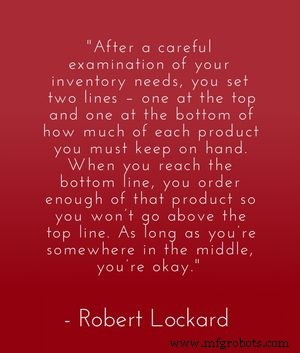
“Ventajas:este método es simple y hace que la tarea de equilibrar el inventario sea bastante sencilla.
“Contras:su simplicidad podría conducir a problemas porque podría pedir demasiados productos o agotarse antes de que lleguen”. – Robert Lockard, 4 métodos de control de inventario que debe conocer , Software de Sistema de Inventario; Twitter:@Fishbowl
“Los productos de categoría A serán los máximos abarroteros en ventas y los productos insignia con mayor margen . Por lo general, el 20% superior de los productos en el surtido que contribuyen al 80% de las ventas totales se clasifican en una categoría en la que se requiere un control estricto del inventario para garantizar que no haya pérdidas en las ventas. El 20 % de los productos que contribuyen al 80 % de las ventas se conoce como regla 80-20 o principio de Pareto
“Los productos de categoría C son los últimos en la línea y contribuyen menos a las ventas. Estos artículos son marginalmente importantes para el negocio y se conservan únicamente con el único propósito de satisfacer los requisitos del cliente.
“Los productos de categoría B son importantes para el minorista, pero son menos importantes en comparación con los productos de categoría A”. – Suresh Ram, Tipos de sistemas de control de inventario , Discuta la venta al por menor en detalle
“El inventario administrado por el proveedor no es nada nuevo; de hecho, existe desde hace mucho tiempo y es mucho más común de lo que piensas. Si alguna vez trabajó en un restaurante, habría visto al "hombre del pan" aparecer todos los días, revisar su inventario (ver físicamente sus panes, bollos, etc.), luego salir a su camión y abastecerlo. . En una barbería, muchos de los productos para el cabello que vende o usa tu barbero (sí, soy de la vieja escuela, voy a una barbería) también son administrados por el proveedor. En este caso, es probable que sea el representante de ventas de ese producto el que realmente “gestione” el inventario, y puede reabastecer la barbería desde la cajuela de su automóvil. En la antigua ferretería independiente, los artículos como tuercas, pernos, arandelas, juntas tóricas, etc. a menudo eran administrados por el proveedor. En empresas más grandes, es posible que el proveedor administre las cajas de envío, los suministros de oficina o los suministros de limpieza/mantenimiento”. – Dave Piasecki, Inventario administrado por el proveedor (VMI):qué es y cuándo tiene sentido usarlo , InventoryOps.com
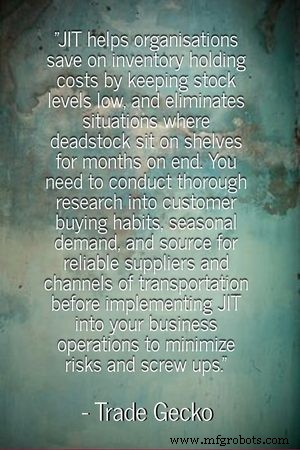
4. El método de control de inventario Justo a tiempo se considera una práctica riesgosa, pero reduce el volumen de inventario que una empresa mantiene disponible, lo que puede reducir los costos generales. “El método Just In Time (JIT) funciona para disminuir el volumen de inventario que tiene una empresa disponible. Se considera una técnica riesgosa porque solo compra inventario unos días antes de que se necesite para su distribución o venta, de modo que los artículos lleguen justo a tiempo para su uso.
“JIT ayuda a las organizaciones a ahorrar en costos de mantenimiento de inventario al mantener los niveles de existencias bajo, y elimina situaciones en las que el material muerto permanece en los estantes durante meses. Debe realizar una investigación exhaustiva sobre los hábitos de compra de los clientes, la demanda estacional y la fuente de proveedores y canales de transporte confiables antes de implementar JIT en sus operaciones comerciales para minimizar los riesgos y los errores". - Técnicas de gestión de inventario , Comercio Gecko; Twitter:@tradegecko
“Las principales diferencias entre estos modelos son que en un modelo de cantidad de orden fija debe haber un monitoreo continuo para garantizar que las órdenes se realicen cuando los niveles de inventario sean reducido al nivel adecuado. Los niveles de inventario en un modelo de período de tiempo fijo solo se verifican en el momento en que se debe realizar un pedido. En el modelo de cantidad de pedido fijo, los niveles de inventario suelen ser más altos y este sistema tiende a usarse para artículos más caros e importantes. También requiere más tiempo para mantener porque los modelos de inventario deben medirse constantemente.
“Los modelos de cantidad de pedido fija se utilizan en situaciones muy estables donde la demanda del producto es constante, el tiempo de entrega del producto es conocido y confiable, el precio no varía, los costos de pedido son constantes y todos los pedidos del producto se completarán”. – Peter Carr, Semana 7:Gestión de inventario , BE 603 Gestión de operaciones y cadena de suministro (ofrecido por Conrad Center for Business Entrepreneurship and Technology de la Universidad de Waterloo); Twitter:@UWaterloo
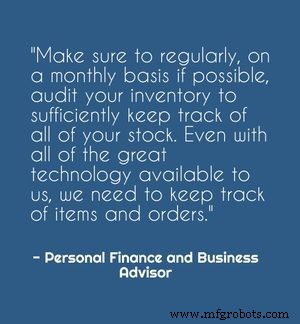
- Primero, un inventario mal administrado puede generar un aumento innecesario en el capital de trabajo. El exceso de fondos podría haberse dirigido de manera fructífera para impulsar las iniciativas de crecimiento de la empresa o los esfuerzos de investigación y desarrollo.
- En segundo lugar, la gestión eficaz del inventario daría lugar a unos costes de almacenamiento bajos, lo que a su vez conduciría a un aumento de los beneficios de la empresa. El espacio de almacenamiento es caro; si puede administrar bien su inventario y puede reducir la cantidad de productos que necesita almacenar, necesitará menos espacio, lo que a su vez conducirá a bajos costos de alquiler del almacén.
- En tercer lugar, puede ayudarlo a satisfacer a sus clientes brindándoles los productos que necesitan de la manera más rápida. La mala gestión del inventario conduce a una menor disponibilidad de bienes y un mayor tiempo de entrega. Por lo tanto, si desea obtener esas estrellas de satisfacción del servicio, debe administrar bien su inventario.
- Cuarto, los bienes almacenados en el inventario durante un largo período pueden estropearse. Esto conduce a gastos generales innecesarios en la operación de un negocio. Por lo tanto, la gestión adecuada del inventario puede ayudarlo a reducir estos costos en gran medida.
- En quinto lugar, si tiene inventarios dispersos en varias ubicaciones, necesita un sistema adecuado para administrar esos inventarios en función de la oferta y la demanda. Las técnicas de gestión de inventario pueden ayudarlo a recorrer un largo camino en la gestión de múltiples inventarios”. – Laran Joseph, Técnicas de gestión de inventario y su importancia , Blog de Udemy; Twitter:@Udemy_Blog
- Basado en la web: Tener una solución basada en la web resultará invaluable. Este tipo de sistema de control de inventario suele ser más económico, ofrece más funciones y, por lo general, es más fácil de implementar.
- Inventario móvil: ¿Puede llevar consigo su sistema de gestión de inventario? Estar basado en la web no es suficiente, así que asegúrese de que su sistema sea compatible con iPad, iPhone, Android o Windows Mobile.
- Integración de código de barras: El código de barras le permite reducir los errores de entrada de datos, acelerar los procesos de control de inventario y facilitar las operaciones diarias.
- Conversión de unidades de medida: El uso de un sistema que comprenda que su unidad de medida de compras a menudo es diferente a la unidad de medida de su inventario es vital. Puede comprar su "artilugio" por "caja" de Acme Supply, pero puede entregar ese mismo "artilugio" a su personal por la unidad de medida "cada uno". Muchas veces puede ver un escenario en el que puede haber 50 "cada uno" en un "caso" que se ordenó. Es fundamental que su sistema de gestión de inventario conozca y comprenda este proceso.
- Importación de datos: Importar sus datos inicialmente le ahorrará horas, si no días, de escribir a mano todos sus suministros. Asegúrese de verificar esta funcionalidad.
- Procesos por lotes: A nadie le gusta tener que realizar la misma tarea una y otra vez; asegúrese de que el sistema que elija ofrezca transacciones masivas o procesos masivos para convertir trabajos grandes en tareas fáciles de realizar.
- Recuentos de ciclos/físicos: Eventualmente, la cantidad de suministros en sus estantes no será igual a la cantidad de ese artículo en su software de administración de inventario, por lo que el conteo cíclico o el conteo físico de sus suministros debe ser rápido y fácil. Asegúrese de que el sistema que seleccione ofrezca una manera rápida y fácil de realizar estas funciones.
- Alertas y notificaciones: Manténgase informado con alertas de par bajo y otras notificaciones del sistema automáticamente. A nadie le gustan las sorpresas y con las alertas automáticas nunca volverá a sorprenderse”. – 5 mejores prácticas sencillas para una excelente gestión de inventario , El Grupo de Herramientas; Twitter:@TheToolkitGroup
Conceptos básicos de control de inventario
- Debe advertir al personal de piezas con mucha antelación que una pieza se está agotando del stock.
- Debe enumerar el precio de compra histórico de una pieza para que, si el precio cambia, el administrador pueda analizar el problema y determinar si este cambio es un aumento de precio o se debe a una facturación incorrecta.
- Debe enumerar los proveedores que ofrecen los mejores precios.
- Debe proporcionar tasas de uso anteriores para que el administrador pueda determinar los niveles de inventario adecuados.
- Debería requerir la menor escritura posible, especialmente por parte de los mecánicos”. – John Dolce, 15 consejos para mejorar el control de su inventario , flota de servicios públicos profesional; Twitter:@UtilityFleetPro
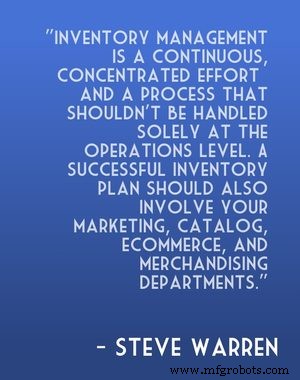
10. Haz un plan primero, luego ejecútalo. “La gestión de inventario es un esfuerzo continuo y concentrado, y un proceso que no debe manejarse únicamente a nivel de operaciones. Un plan de inventario exitoso también debe involucrar a sus departamentos de marketing, catálogo, comercio electrónico y comercialización.
“Al administrar su inventario con un calendario promocional maestro, todos ganan:su equipo de compras entiende cuándo y cuánto producto comprar, su cumplimiento El proveedor sabe cuándo preparar espacio de almacenamiento adicional, y el personal de su centro de contacto puede anticipar un mayor volumen de llamadas.
“Agregue los pronósticos de ventas de años anteriores a su calendario de inventario para estar aún más preparado para los picos de demanda estacionales”. – Steve Warren, 4 consejos para una gestión eficaz del inventario , comerciante multicanal; Twitter:@mcmerchant
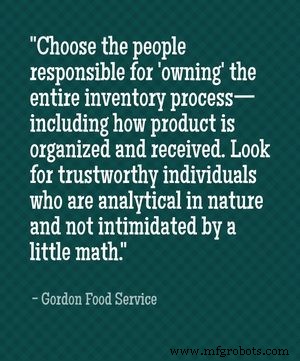
13. Asigne al equipo de gestión de inventario adecuado la tarea de hacerse cargo de los procesos de control de inventario de su organización. “Elija a las personas responsables de 'poseer' todo el proceso de inventario, incluida la forma en que se organiza y recibe el producto. Busque personas confiables que sean analíticas por naturaleza y que no se sientan intimidadas por un poco de matemáticas”. – 7 consejos para mejorar el inventario de su operación y reducir el desperdicio de alimentos , Servicio de Alimentos Gordon; Twitter:@GFSDelivers
- Mantener una amplia variedad de existencias, pero no distribuir demasiado las que se mueven rápidamente;
- Aumentar la rotación del inventario, pero sin sacrificar el nivel de servicio;
- Mantener las existencias bajas, pero sin sacrificar el servicio ni el rendimiento.
- Obtener precios más bajos al realizar compras por volumen, pero sin terminar con un inventario de movimiento lento; y
- Tener un inventario adecuado a mano, pero no quedar atrapado con artículos obsoletos.
“El grado de éxito al abordar estas preocupaciones es más fácil de medir para algunos que para otros. Por ejemplo, calcular la tasa de rotación del inventario es una medida simple del desempeño gerencial. Este valor brinda una guía aproximada mediante la cual los gerentes pueden establecer metas y evaluar el desempeño, pero se debe tener en cuenta que la tasa de rotación varía según la función del inventario, el tipo de negocio y cómo se calcula la proporción (ya sea sobre las ventas o el costo de los bienes). vendido). Los índices de rotación de inventario promedio para industrias individuales se pueden obtener de las asociaciones comerciales”. – Gestión de inventario:gestión de inventario exitosa , IPSCMI
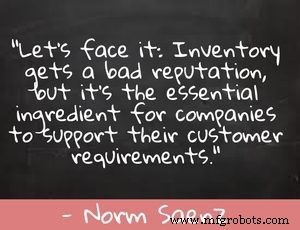
16. El inventario tiene mala reputación, pero es una función crítica para los negocios que abarcan casi todas las industrias. “Seamos realistas:el inventario tiene mala reputación, pero es el ingrediente esencial para que las empresas respalden los requisitos de sus clientes. Deben tener lo que sus clientes objetivo necesitan para mantener su negocio y vencer a la competencia. Este último hecho es la razón por la que tantas empresas mantienen un inventario de movimiento muy lento o "muerto" en los estantes.
“Los requisitos de inventario en una empresa determinada varían según los requisitos de atención al cliente y el tipo de negocio que es un fabricante, minorista , distribuidor mayorista o empresa de comercio electrónico. Incluso dentro de estas categorías generales de canales, habrá diferencias significativas dentro de la gestión de inventario en productos farmacéuticos/medicamentos, alimentos, prendas de vestir, mercancías generales, automóviles, electrónica, materiales de construcción y otros tipos de negocios.
“Mientras que la industria y los servicios los niveles influyen en las prácticas de inventario, existen razones comerciales generales por las que algunas empresas tienen un exceso de inventario, como el riesgo y la incertidumbre de la cadena de suministro y del proveedor; demanda variable del cliente y precisión del pronóstico; nivelación de estacionalidad; problemas de tiempo de entrega; cobertura de precios; riesgo de perder clientes leales; y marketing impulsando las ventas con nuevos productos”. – Norm Saenz, director general de St. Onge; Don Derewecki, consultor sénior de St. Onge, Gestión de inventario 101:hora de revisar los principios , Gestion de logistica; Twitter:@LogisticsMgmt
“Puede que se esté preguntando qué tiene que ver el control de inventario con si una tienda experimenta o no tiempo de inactividad , a lo que yo respondería, 'mucho'. Un mal control de inventario es un síntoma de un problema mucho más profundo, a saber, un mal plan de mantenimiento y/o gestión de instalaciones.
“Uno de los pasos clave para cualquier sistema de gestión de mantenimiento es conocer cada equipo a tu cargo. Esto también incluye información sobre la maquinaria, incluida la antigüedad de cada unidad, quién es el proveedor, la información de contacto del proveedor, la expectativa de vida del producto, los procedimientos de mantenimiento sugeridos... la lista sigue y sigue.
“Al conocer esta información vital, puede desarrollar un plan de mantenimiento sólido para garantizar que su equipo continúe funcionando correctamente, lo que ayuda a evitar un posible escenario de tiempo de inactividad en el futuro". - Lisa Richards, Elimine el tiempo de inactividad con estos consejos de control de inventario , MapCon; Twitter:@MAPCONtech
“El siguiente sistema manual es simple y fácil de usar que pone el control del inventario en manos de una persona mientras aún permitiendo que cualquier persona en la oficina use los suministros cuando sea necesario sin tener que consultar primero con otra persona. Si se desea, también se pueden crear subsistemas para abastecer cada sala de examen o estación de trabajo.
“El sistema:
- Determine el ciclo de compra de cada artículo (con qué frecuencia lo comprará:semanal, mensual, trimestral, etc.) según la utilización y el espacio de almacenamiento. La mayoría de las oficinas deben pedir suministros semanal o mensualmente. Si tiene un subsistema para salas de examen o estaciones de trabajo, su ciclo se aplicará para reabastecer esas áreas desde la sala de suministros.
- Determine la cantidad de cada artículo que normalmente se usa durante cada ciclo de compra.
- Al principio, compre una cantidad suficiente de cada artículo para durar dos ciclos de compra y cree dos paquetes de cada artículo. Cada paquete debe contener suficiente de cada artículo para durar un ciclo de compra (excepto artículos con fechas de vencimiento o artículos de temporada, como la vacuna contra la gripe). Envuelva cada paquete con un trozo de cuerda o una banda elástica, o coloque cada paquete en una caja, bolsa u otro recipiente por separado. A cada paquete, adjunte una etiqueta reutilizable etiquetada con el nombre del artículo, el proveedor, el último precio pagado por unidad, el ciclo de compra, el monto del pedido y el número de artículos del paquete.
- Cuelgue de manera prominente un sobre marcado como "Reordenar sobre". Pon etiquetas aquí” en la sala de suministros.
- Cuando se necesitan suministros, cualquier miembro del personal puede acceder a un paquete, quitar la etiqueta y colocar la etiqueta en el sobre de reorden. Debe quedar un paquete completo y uno parcial para el elemento al que se accede.
- Asigne a un empleado de control de inventario para que procese etiquetas y rótulos de control de inventario y solicite nuevos suministros de acuerdo con el ciclo de compra. Si su empleado solicita suministros en línea, pídale que verifique si el proveedor en línea tiene una función en la que se pueden realizar pedidos repetidos equivalentes a uno de sus paquetes de forma rápida y sencilla.
- Cuando llegan los suministros, el empleado de control de inventario debe ser el único que abra la entrega, compare la factura de entrega con el pedido original para confirmar la precisión y guarde los artículos.
- Vuelva a agrupar artículos y vuelva a colocar la etiqueta usada en el nuevo paquete para completar el ciclo de pedidos.
- Coloque el nuevo paquete de artículos detrás del paquete restante, que puede que ya se haya abierto si la demanda de un artículo aumentó inesperadamente (por ejemplo, para rotar el inventario).
“Puede cambiar los proveedores, los ciclos de compra, las cantidades de los pedidos y el tamaño del paquete en cualquier momento que lo necesite. Simplemente modifique las etiquetas para reflejar los cambios”. – Keith Borglum, Preguntas y respuestas:Consejos para ahorrar dinero en suministros y controlar el inventario , Red de Medicina Moderna; Twitter:@MedEconomics
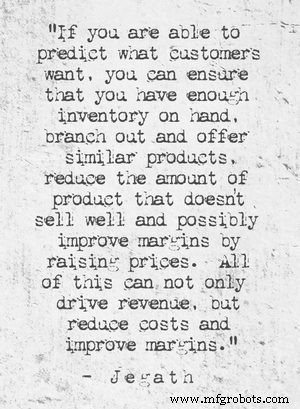
19. Las pequeñas empresas no deben ignorar la necesidad de contar con un sólido sistema de control de inventario. Al considerar métodos y aplicaciones de software, en lugar de optar por la aplicación gratuita o menos costosa, elija un sistema que pueda crecer con su negocio. “Puede estar pensando que, dado que su negocio es pequeño, no necesita gastar mucho tiempo y dinero en hacer un seguimiento de mi inventario. Con el tamaño de su negocio, puede vigilarlo usted mismo sin necesidad de configurar un sistema especial.
“Esta línea de pensamiento podría causarle problemas. La gestión de inventario implica algo más que contar su inventario. Un buen sistema de gestión de inventario también incluye el seguimiento del inventario a medida que se envía a los clientes. A partir de una gestión adecuada del inventario, puede saber qué productos se venden bien y cuáles no, de modo que sepa qué almacenar más y qué artículos considerar poner a la venta para moverlos. Si puede predecir lo que quieren los clientes, puede asegurarse de tener suficiente inventario a mano, diversificarse y ofrecer productos similares, reducir la cantidad de productos que no se venden bien y posiblemente mejorar los márgenes aumentando los precios. Todo esto no solo puede generar ingresos, sino también reducir costos y mejorar los márgenes.
“El software de administración de inventario para pequeñas empresas también puede ayudar con la administración de efectivo. Al comprender qué productos se venden y usar esto para controlar su comportamiento de compra justo a tiempo, puede reducir el ciclo de conversión de efectivo para su negocio. Del mismo modo, al eliminar productos y skus que no se venden, puede reducir la cantidad de efectivo inmovilizado en productos de conversión de efectivo largos. Todo esto es fundamental para las pequeñas empresas. La pregunta no es si necesito un sistema de gestión de inventario, sino cuánto dinero y tiempo debo invertir. Entonces también debes considerar el crecimiento. Cambiar de sistema más tarde puede ser muy perturbador y doloroso. Si bien el software gratuito de administración de inventario está disponible para su pequeña empresa, es posible que esa no sea la mejor estrategia a largo plazo. Es mejor comprar un servicio o producto que pueda crecer contigo”. – Jegath, Consejos para propietarios de pequeñas empresas:impulsar los ingresos a través del software de gestión de inventario para pequeñas empresas , OrdoroBlog; Twitter:@ordoro
“Durante mucho tiempo, las organizaciones tenían que realizar la gestión de inventario de forma manual. La dificultad de rastrear el inventario en diferentes cantidades y con diferentes características se magnifica cuando se utilizan procedimientos manuales. Un módulo de control de inventario puede simplificar la gestión de inventario a través de un mejor mantenimiento de registros e informes automatizados. Desafortunadamente, los módulos de administración de inventario a menudo se subutilizan.
“Muchos gerentes de mantenimiento asumen erróneamente que la administración de inventario viene como una función automática de los sistemas de administración de mantenimiento, pero el software de mantenimiento solo puede simplificar y automatizar un proceso que ya es efectivo”. – Carol Owens, Consejos para simplificar la gestión de inventario con software de control de mantenimiento , Business-Software.com; Twitter:@BiznessSoftware
Data Collection and Analysis Tips for Effective Inventory Control
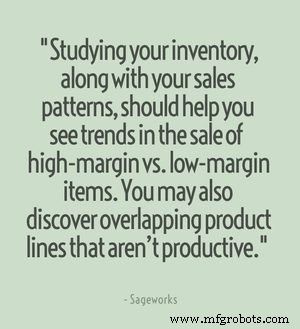
22. Find a way to evaluate what products are moving and what products are not. “One of the first ways to use your inventory information is to examine by product what is moving and what isn’t. Doing this on an ongoing basis will help identify products that may need to be discounted in order to replace them with faster selling items or in order to generate some cash. Studying your inventory, along with your sales patterns, should help you see trends in the sale of high-margin vs. low-margin items. You may also discover overlapping product lines that aren’t productive.” – Sageworks, 6 Tips to Improve Inventory Management , Funding Gates; Twitter:@FundingGates
23. Measurement is essential. You cannot control what you don’t measure. “Metrics are essential to a well-run supply chain. Metrics for their own sake, however, are worthless. The purpose of a metric is to drive change when the variable you are measuring trends in the wrong direction.
“A number of different metrics are useful for inventory management. Days supply by product and location based upon forecast is an excellent metric at the SKU level.
“When analyzing roll-up numbers for a product line, warehouse, or any other higher level, however, days supply is misleading because the lows cancel the highs and hide imbalances. At the higher level, inventory velocity is a much better measure of inventory health.
“No metric is useful, however, unless it is acted upon. Constant vigilance and early response to imbalances are the keys to ensuring best-practice inventory management.” – Jane B. Lee, 8 Common-Sense Rules for Inventory Management , Inbound Logistics; Twitter:@ILMagazine
24. Calculate your total costs. “It goes without saying that getting your inventory levels right is imperative, but what about the right quantities of your highest-performing brands and products? Maximizing sales of the goods with the most attractive margins can sometimes be tricky because of quantity discounts, special orders, and changes in wholesale prices (that you might not be aware of).
“It’s why looking carefully at total costs lets you know which products have the best margin, rather than just sell the fastest.
“Why calculate total costs?
- Focus on brands and vendors that yield the highest profits
- Find out which products perform the best by quantity margin
- Better manage discounts with a precise account of item cost” – Stephanie Braun, Fun Tips! 5 Ways To Improve Inventory Control Today , Lightspeed POS; Twitter:@LightspeedHQ
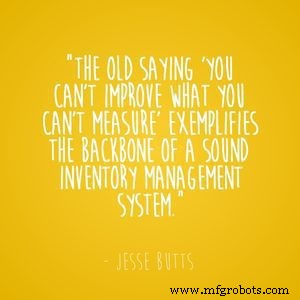
25. Track both inventory and sales data. “The old saying ‘you can’t improve what you can’t measure’ exemplifies the backbone of a sound inventory management system. If you haven’t yet started keeping thorough records, there’s no time like the present. As you create this records system, consider how it will accommodate the most vital inventory components:
- sales orders — documents comprising your customers’ purchase orders (requests for your product or service) in a format tailored for your business
- bills of materials — documents stating the inventory components (and hopefully labor) required to complete products or services
- work orders — if you’re involved in manufacturing, you’re probably familiar with these documents that include products’ details and their respective bills of materials
“You likely already have a system for recording transactions that includes sales orders (we hope). But most entrepreneurs haven’t taken the time to complete bills of materials, and for good reason:They are time-consuming. But, in the end, the benefits far outweigh the costs.
“Bills of materials are considerably easier to create for a retail storefront than for, say, a restaurant. In the food service industry, one sales order can relate to multiple bills of materials which, in turn, can require a few primary components and many others in small amounts. If you fall into the latter camp, determine the quantities of various invoice items needed for the appropriate bills of materials.” – Jesse Butts, How to Establish a Practical Inventory Management System , BizFilings; Twitter: @Toolkit
26. Check all stock inwards to account for errors in packing and other issues that may be missed if you simply assume the numbers match up. “The first focus should always be to check what actually gets delivered against what you have ordered from your supplier. It is so easy to assume that the numbers match up, but from talking to our customers we note that a good 1% to 2% of stock orders are incorrectly packed. If you just assume that you have the correct numbers of products when you add the inventory to your shelves you are liable to be short stocked when you receive a customer order. Another issue is that you might actually have more stock than you need and you won’t know when to reduce prices to move it or order more when you don’t need to.” – Stock Control and Inventory Management Tips , Cloud Fulfillment; Twitter:@CloudFulfillment
27. Centralize your data. “Regardless of how your inventory is set up physically, from a tracking perspective it should all be consolidated. This is especially the case if you have a web store and a physical one. Otherwise, you’ll appear disorganized and the process of buying could be confusing. As a bonus, being able to order online and either pick up or return in-store can seriously boost sales.” – 5 Tips for Streamlining Your Inventory Control Process , Blue Chip Inventory Service Int’l.; Twitter:@rodwalsh98
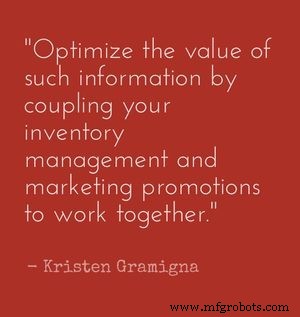
28. Inventory trends inform marketing plans. “Accurate inventory management incorporates what you know about customer and product demand from the past and present to (ideally) predict your best course of action in the future. A point of sale system can help quantify product level demand in tandem with recurring sales patterns, including those that fluctuate with some predictability (like seasonality, lifestyle occasions that impact your target audience and perhaps, local events).
“Optimize the value of such information by coupling your inventory management and marketing promotions to work together. For example, such insights can reveal potential opportunities to leverage quantity-based pricing vendors may offer, while at the same time empowering you to offset times of lower demand with promotions or ‘packaged’ deals that strategically drive sales, while moving the inventory that you acquired at a low cost.” – Kristen Gramigna, Keep Track of Your Precious Cargo:Tips for Inventory Management , Business.com; Twitter:@businessdotcom
29. Automate tracking with barcode labels and/or inventory management applications. “Another possible inventory management error is failure to track what you receive and what you sell. This can lead to losses, especially if you’re paying for products that are never showing up at your business, so some sort of tracking system is imperative. Automating the process with a barcode system and/or inventory management application is the smoothest way to handle this; note that the BizXpert app offers some useful inventory management features.
“Cycle counts are also recommended. Every day, pick a handful of items and count how many you have, comparing the number against what you have in your records. Pay special attention to big-selling and hot ticket items.” – Three Inventory Management Errors (And How to Avoid Them) , BizXpert; Twitter:@BizxpertApp
30. For many industries, including healthcare, inventory tends to follow the 80/20 rule. “Hospital inventory, like many things in life, often follows an 80/20 rule. 80% of the value of your inventory will be composed of just 20% of your actual product and most of those valuable items – whether they be assets, med-surg supplies, consignments or medication – fall into the departments of OR or Pharmacy. Plan your inventory efforts accordingly. Spend 80% of your time and energy optimizing the ordering and organization of the equipment, supplies and pharmaceutical products in these categories.” – Top 10 Tips for Hospital Inventory Management , Reliant Inventory Services
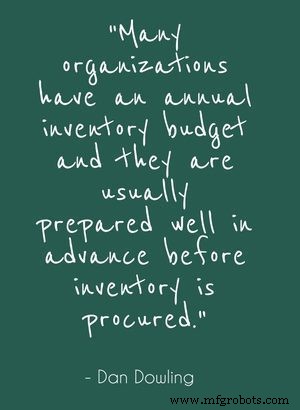
31. Inventory budgeting is a critical component of effective inventory control. “Many organizations have an annual inventory budget and they are usually prepared well in advance before inventory is procured. Budgets should include the total cost of ownership to keep inventory on hand during that year’s account period. This includes materials cost, fixed operational costs, carrying costs, logistics costs, redistribution costs and additional miscellaneous costs that contribute to the total costs of ownership.” – Dan Dowling, 6 Inventory Control Techniques for Stock Optimization , EazyStock Blog; Twitter:@EazyStock
32. When considering new inventory control software applications, be sure the cost is commensurate with functionality. “As you might expect, there are a lot of different types of inventory planning and control software out there. One of the biggest differences between many new solutions is whether they take advantage of cloud computing, or if they remain as locally installed software packages. For example, according to Inc.com , many providers of inventory control systems offer exclusively online, and full-service hybrid, versions of their software. The exclusively online versions are typically more limited in their functionality, while the full-service versions come with a higher price tag, but offer a greater number of services.” – Pat VanPutte, Inventory Control Systems Protect Your Bottom Line , NSA Computer Exchange Corp.; Twitter:@NSAComputerExch
Knowing Your Inventory and Your Company’s Needs
33. Don’t get caught with too much inventory. “Afraid of being caught short, it’s easy to spend too much on inventory, which can eat up working capital and erode profits. Warehousing isn’t free, of course, and inventory that sits on a shelf is subject to damage, depreciation, and even obsolescence. Old inventory can be very hard to move. Your options aren’t great,’ says Paul Huppertz, a logistics expert with The Progress Group, a supply chain consulting company based in Atlanta. ‘You may end up marking it down, selling to discounters, or shipping it to overseas liquidators.’
“To fix it: Start with some decent projections of how much supply you’ll need and when you’ll need it. The best gauge is what you’ve sold in the past. If you’ve sold 100 items per month for the past 12 months, chances are that you’ll need 100 this month. Then there’s seasonality:Do you usually see a fourth quarter spike with holiday sales? Or, if you’re in the home and garden business, do you see more activity in the spring selling season? ‘You can also identify and quantify less obvious patterns such as month-end spikes,’ says Huppertz.” – Lisa Girard, Five Steps to Painless Inventory Management , Entrepreneur; Twitter:@lisagjournalist
34. You should be able to break down your inventory into three basic categories:safety, replenishment, and excess or obsolete stock. “This breakdown makes it easier to make sound decisions about appropriate levels for each of these three areas. It helps determine the minimum safety stock needed to provide an insurance policy against supply chain problems either from manufacturing glitches or distribution uncertainties so that customers get what they ordered. It’s useful for pinpointing the amount of inventory required to replenish deliveries every two weeks. And it helps companies find ways to avoid a backlog of excess or obsolete inventory.” – Pratap Mukharji, Sam Israelit, Francois Faelli, Thierry Catfolis and Raymond Tsang, Ten ways to improve inventory management , Bain &Company; Twitter:@BainAlerts

35. Even with the most sophisticated automated data collection systems, a regular inventory audit is still valuable for keeping precise tabs on your inventory. “Make sure to regularly, on a monthly basis if possible, audit your inventory to sufficiently keep track of all of your stock. Even with all of the great technology available to us, we need to keep track of items and orders. This will help you to understand what is really selling and what is dead stock. Getting rid of dead stock is key to running an efficient warehouse operation. All you have to do is create a list of every product you have on your shelves – simple really.” – 5 Helpful Tips for Easy Inventory Control , Personal Finance and Business Advisor
36. Don’t be afraid to re-evaluate your company’s inventory control needs. “At what point do you realize that your approach to inventory management needs to change?
“Is it when you’re sending someone out for a 4-1/2-inch grinder and they’re gone over an hour?
“Or maybe it’s when you realize that you have hundreds of thousands of dollars—maybe millions—tied up in inventory, but you still don’t have exactly what you need the moment you need it.“If this sounds familiar, you’re not alone.“These are common practices in manufacturing environments where meeting production standards and schedules is the number-one priority, no matter what the cost. At some point, however, your finance department may recognize just how much time, money, resources and valuable shelf space is wasted on less–than–perfect inventory management practices. These days every company wants to streamline operations, improve productivity and gain that competitive edge. If you haven’t done it yet, re-evaluating your own inventory management system can help you accomplish some of these goals and significantly boost your bottom line.” – 5 Tips for Getting Started With Vendor-Managed Inventory , Grainger; Twitter:@grainger
37. A CMMS is the backbone of effective inventory management and control for facilities. “The CMMS is the backbone of inventory management and control. Besides the typical modules —work orders, equipment records, material stores inventory, project management, standard reports, work-scheduling databases — the CMMS query system can yield summary inventory reports that supervisors and managers need.
“When each work-order status indicates the material is available, the work order is ready to go, and the maintenance planner can schedule it with the confidence that a lack of materials will not delay the job. Managers also can monitor the trend of work orders awaiting material.
“With real-time inventory control, the need for physical inventory decreases, especially if entries are accurate and complete. Out-of-stock trends can alert the stores supervisor to specific items that need expediting before they lead to equipment downtime. Managers also can monitor inventory-valuation trends efficiently.” – Thomas A. Westerkamp, CMMS:Backbone of Inventory Management and Control , FacilitiesNet; Twitter:@Maintenance_Mag
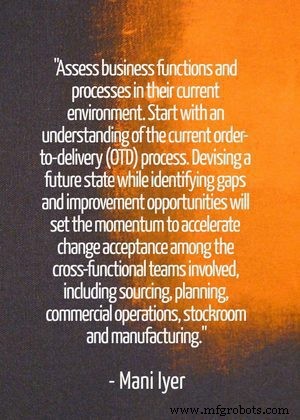
38. Conduct a business assessment. “Assess business functions and processes in their current environment. Start with an understanding of the current order-to-delivery (OTD) process. Devising a future state while identifying gaps and improvement opportunities will set the momentum to accelerate change acceptance among the cross-functional teams involved, including sourcing, planning, commercial operations, stockroom and manufacturing. Key activities in this stage should include:
- Study “As-Is” planning and execution process within the OTD process . Aim to have an unbiased assessment of current processes and practices. Start by interviewing a representative set of stakeholders who perform the same job within each function of the OTD process. Follow up with brainstorming sessions that involve key stakeholders from each function, which will help them understand their upstream and downstream process and address any issues arising out of lack of clarity of roles and responsibilities. These stakeholders should also voice their opinion on the desired “As-Is” state to establish a baseline against which improvements can be measured, and to effectively manage change through shared responsibility among their teams. Organizations should also consider conducting lean workouts among a cross-functional team of subject matter and Six Sigma process experts to understand redundant and non-value-added steps in the process due to multiple hand-offs between various functions within the OTD process.
- Summarize findings and gaps in data, process and practices. One of the ways to effectively capture the gaps in material planning and execution practices is through self-evaluation score sheets. A score sheet typically enlists the various planning and execution categories, and asks the functional owners to score according to the importance and effectiveness of each practice. Typical scoring criteria used is 1 (low), 5 (medium) and 9 (high) to clearly differentiate high impact gaps from lesser ones. For a more robust and objective view, third party service provider can also assist with benchmarking current processes against some of the best run companies in the industry.
- Devise “To-Be” planning and execution OTD process. Resource and system limitations may warrant a “To-Be Intermediate” state before moving to the ideal state. The objective is to outline a streamlined, robust and sustainable process that is aligned to the overall objective of optimizing inventory, customer service levels and variable costs. Organizations then begin to migrate to ideal state once resource and system limitations are addressed.
- Communicate to the whole group the identified improvement opportunities and goals . One of the biggest challenges faced during assessment is change resistance. Data-based inferences and identification of change catalysts is the key to driving fast adoption of more easily implemented improvements. By seeing immediate results, stakeholders will be better engaged to support additional and more sweeping process changes.” – Mani Iyer, Senior Business Manager, Genpact, Inventory Optimization:Five Steps to Improve Process Effectiveness , IndustryWeek; Twitter:@IndustryWeek
39. Understand your sales cycle and customer buying patterns to gain a better understanding of your customers. Effective inventory control is essential for customer service. “Inventory control is a customer service issue. Successful inventory management involves striking that balance between not having enough inventories on hand and having too much. Either you have the cost of excess inventory or the cost of a lost sale. It is painfully obvious which is lesser evil of the two.
“In order to conduct proper inventory control, you must have the ability to look at past sales and predict future demand. When forecasting your demand, you must learn from your past mistakes. Previous marketing promotions must be tracked closely to measure the impact of sales increases. Understanding your sales cycle and customer buying patterns will help you gain a greater understanding of your customers.” – James Ellis of Central Oregon Community College, Inventory Control:An Essential Element of Good Customer Service , Cascade Business News; Twitter:@cascadebusnews
40. Effective inventory control can reduce harmful consequences from mishaps such as the use of outdated or expired materials, such as those used in pharmacy preparations. “Large pharmacies, especially compounding pharmacies, often produce “stores of unwanted chemicals” used in the preparation of prescriptions. These chemicals are known as “bulk compounding chemicals,” and include substances such as tar, phenol and sulfur. Between the chemicals used to prepare prescriptions, pharmacies must also keep track of the compounds and drug products that are ingredients of the final medications. Given the many materials and types of chemicals used and produced, it is especially important for managers to use chemical inventory management systems to organize and keep track of the chemicals that enter and leave a facility.
“As mentioned above, the NECC used expired ingredients in their medications, which likely exposed a number of patients to adverse effects. Additionally, chemicals were not properly labeled. Using a chemical inventory management system prevents such oversight and in all likelihood, NECC lacked such a system. For compounding pharmacies and other such companies which would greatly benefit from tracking chemical supplies, let’s examine three ways a chemical inventory management system can help improve life for both employees and customers:
- Accurate data: The FDA has promised to clamp down on compounding pharmacies as a result of 2012’s incident; however, a random inspection should not be a reason to stress when facilities have a best practices chemical inventory management system in place. Many systems have gone completely digital by using barcode labeling and even providing remote inventory control. In this way, researchers and pharmacists can easily update inventory records, thus providing accurate and real-time data on the chemicals in stock.
- Expiration no more: Expired medications can be dangerous for patients; however, monitoring the expiration dates for both the chemicals used to produce prescription drugs as well as the chemical components of these drugs can be overwhelming. With a chemical inventory management system, managers can easily monitor expiration dates remotely, thus uncovering new opportunities for saving money by ordering less of a minimally used chemical, for example.
- Promote a safety culture: The most damning evidence against the NECC was its inability to create a culture of safety, one in which clear standards and practices are present and individuals are aware of the locations and proper disposal of items. The absence of such a culture perhaps helped contribute to the contamination of medications and it is no wonder that 14 former NECC executives and technicians were indicted on federal charges related to the outbreak. By implementing a chemical management system, leaders help ensure that employees understand the importance of safety and may act accordingly to protect the interests of all.
“What occurred at the NECC proved to be a fatal flaw for the company. Though the presence of a chemical management system may not have prevented the outbreak, if such a system were in place and used in conjunction with a digital notebook capable of recording the results of sterility tests, for example, the likelihood that such a mistake could occur would have been much less.” – Lilian N., Eliminating Harmful Substances Before They Reach Patients with Chemical Inventory Management , Biovia; Twitter:@3dsBIOVIA

41. If your company must maintain inventory for equipment repairs, consider parts that can be used in a number of applications. “If you store clamps and couplings that can be used in a number of applications, you won’t need to keep as many in stock and space is reduced. Full transition couplings that fit pipes of varying types and sizes within your water or wastewater infrastructure save space and help you stay prepared for multiple scenarios. There are also products that have the versatility to either join or repair pipes.” – David Wheat, Simple Steps For Inventory Control , Municipal Sewer &Water; Twitter:@MSWmagazine
Creating Effective Inventory Control Policies
42. Creating clear policies and processes allows your company’s inventory control function to run like a well-oiled machine. “It can be an uphill battle keeping your company’s inventory effectively organized and managed. There are some subtle nuances that are easy to overlook but should ultimately not be ignored. Compass Technologies, which provides retail point-of-sale, wholesale and distribution services to its customers, offers some helpful advice for inventory and organization management.
- Limit access to inventory. Only those who need to have their hands on inventory and inventory data should be allowed access.
- Establish well defined, user-friendly storage and receipt management policies. Check lists and data tables.
- Create an inventory system that utilizes multiple locations to replenish inventory from multiple sites – minimize distribution costs.
- Clearly map and label inventory areas, easy to read and understand with item descriptions.
- Track annual and seasonal regular inventory demand analysis. Use competitive data for start-up companies.
- Track and document inventory processes, including reviews.
- Inventory data base- GP and Add-On solutions.
- Use inventory alerts to make management aware of stock limits.
- Manage paperwork, purchase orders, receipts and inventory counts with GP for reporting.
- Utilize software add-on solutions to further manage the inventory process.” – Hillary Horning, Compass Technologies, 10 Tips for Smooth and Accurate Inventory Organization and Management , ERPSoftware Blog; Twitter:@erpsoftwareblog
43. All items should have an SKU, barcode, and product specifications. “Similar to a driver’s license, every product needs to have a unique ID number known as a SKU (Stock Keeping Unit). A SKU is vital for internal use as there will be instances where a particular product needs to be found quickly and having an SKU will make it easy to find. Additionally, having a SKU is imperative because another company could have a product named “Black Pants” exactly like and resellers are dealing with multiple vendors, thus creating a need to differentiate between similar products.
“Second, when working with other companies such as resellers whether it be an independent e-commerce store, a brick and mortar store or a big-box chain, a universal barcode/UPC number will be expected. A UPC number is another form of a SKU, but instead it comes in the form of a barcode which can be scanned and identified through a live database powered by GS1. Be cautious not to purchase UPC numbers from anywhere but GS1 or a valid reseller. The whole point of a barcode is to be scanned and looked up via a database, so having a barcode that brings up a different product from another company causes a lot of confusion and could potentially lose customers.
“Finally, it is always good to have a system for listing all your products specifications. Those specifications should have at least the following:
- Product Name
- SKU Number
- UPC Number
- Description
- Color
- Size
- Price
- Weight
- Dimensions (depending on product)” – Raad Mobrem, 6 Tips for Inventory Management , Small Biz Resources; Twitter:@SmallBiz_Help

44. Dedicated inventory control managers or other administrators should be tasked with handling the administrative tasks associated with inventory control, and these roles should be separate from accounting or finance departments. “There are many administrative tasks associated with stock control. Depending on the size and complexity of your business, they may be done as part of an administrator’s duties, or by a dedicated stock controller.
“For security reasons, it’s good practice to have different staff responsible for finance and stock.
“Typical paperwork to be processed includes:
- delivery and supplier notes for incoming goods
- purchase orders, receipts and credit notes
- returns notes
- requisitions and issue notes for outgoing goods
“Stock can tie up a large slice of your business capital, so accurate information about stock levels and values is essential for your company’s accounting.
“Figures should be checked systematically, either through a regular audit of stock – stocktaking – or an ongoing program of checking stock – rolling inventory.
“If the figures don’t add up, you need to investigate as there could be stock security problems or a failure in the system.
“Health and safety aspects of stock control are related to the nature of the stock itself. Issues such as where and how items are stored, how they are moved and who moves them might be significant – depending on what they are.
“You might have hazardous materials on your premises, goods that deteriorate with time or items that are very heavy or awkward to move.” – Stock Control and Inventory , Info Entrepreneurs; Twitter:@chambremontreal
45. Make inventory accuracy a higher priority than order fulfillment. “Raising the priority of accurate inventory is perhaps the most important, yet most difficult, step in inventory accuracy. Many inventory problems arise from pushing a transaction through the system with the intent of going back and fixing the numbers later. In the rush of other emergencies, however, we often forget to go back and correct the numbers in the system. This leads to missed production entries, negative lines of inventory, and a whole mess of other problems. Only by putting systems in place that will prevent an employee from moving forward without the necessary system transaction can you effectively keep accurate records of inventory.
“One example of success that my team recently implemented was changing our accounting system so that it will not process any shipment that contains more inventory than we have on hand. For example, if we’re trying to ship 15 of an item, but our system says we only have 5 in stock, then an alert will pop up and force us to fix the problem before moving forward. This helps us address problems before the product goes out the door. By forcing us to address missed production entries before the product leaves, our modified system helped us eliminate most of our major inventory issues.” – Alex Fuller, 10 Tips to Make Physical Inventory Counts Less Painful and More Accurate , Supply Chain Cowboy
46. Inventory management software is a valuable tool and superior to outdated spreadsheet methods. “Using the right tools for the job is a must. Many companies choose spreadsheets for inventory management software because it seems like the familiar and easy thing to do. Unfortunately, spreadsheets come with built-in risks:it’s far too easy to lose changes or accidentally delete a spreadsheet file. It’s also difficult for multiple people to synchronize their spreadsheets, which further increases the risk for error. Find a low-cost but effective software for managing your inventory, such as Peachtree or QuickBooks. Most organizations overlook these options for inventory management because they’re best known for their accounting features. However, they offer invaluable inventory management software features and a central database to streamline inventory operations, increase accuracy, and minimize the possibility of error.” – 5 Supply Chain Management Inventory Tips , Women’s Distributor Services (WDS); Twitter:@WDSJennifer
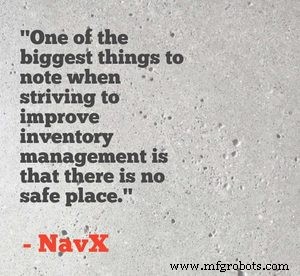
47. Optimizing inventory control requires continuous improvement. “One of the biggest things to note when striving to improve inventory management is that there is no safe place. Maintaining the right balance of inventory levels, properly organizing your warehouse for maximal efficiency, and ensuring that you have complete insight into your processes will go a long way in helping you improve effective inventory management however when you think you’ve succeeded, the worst thing you can do it sit back and relax. Taking a critical approach to operations, including inventory management, is fundamental to maintaining your competitive edge. Be sure to monitor costs as well as performance; if you see that inventory carrying costs are rising, maybe your forecasting isn’t as accurate as it could bet. If customer satisfaction falls, take a look at your order history. If you’re sending out incomplete orders, or items aren’t being sent to customers in a timely manner, dig a little bit deeper. By building the philosophy of continuous improvement into your organization and your inventory management strategy, you will be able to achieve greater efficiency and profitability.” – 3 Tips for Improved Inventory Management , NavX; Twitter:@NAVX_software
48. Cycle counts can be a useful alternative to stock-wide physical inventory counts. “Cycle-counts have become SOP with a growing number of mid-sized firms since more business software packages now provide this functionality. The benefits of employing a cycle-count regimen over periodic stock-wide physical counts are great. Cycle-counts are less disruptive to operations, offer greater specificity in determining what items should be counted and generally force greater discipline into the organization’s inventory management.” – Tips for Improved Inventory Control:Part 5/8 , TBS Automation Systems
49. Take steps to maximize both your profit and resources by involving team members and distributors in key processes. “There are many best practices that any Supply Chain Manager should follow, but a few of the strategies that tend to ensure maximizing not only profits but resources needed include:
- Working with your team and distributor to maximize service and savings; everyone should be clear on the expectations of the strategy you have defined.
- Once strategy is implemented continue consistent monitoring of purchasing behaviors. Many times a focus on efficiencies over time begins to become complacent resulting in overpayment for suppliers and an increase in overall supply chain costs.
- Understand the difference between “cost” and “price.” Many times, the manufacturer costs revealed for the savings analysis do not include the distributor mark-up, holding costs, or the freight costs. Also remember to keep in mind that being able to secure products through a manufacturer directly needs to apply to all of their products in that category, not just one of the more highly utilized items.
- Establish your ability to purchase in the lowest unit of measure. This will ensure that you are not over-ordering on products you may not use frequently or on any consistent basis.
- Be sure of what your GPO compliance requirements are. [This] includes not only volume in units, but may also include dollar-volume commitments. It is important to remember that reducing your pricing on actual supplies may interfere or require an amendment to your GPO agreement in order to maintain compliance. Many times hospitals secure agreements that include commitment to process a set dollar volume through the GPO base agreements that must be fulfilled to maximize the benefits of the entire portfolio.” – Lori Pilla, Vice President, Amerinet Clinical Advantage and Supply Chain Optimization, Amerinet Inc., St. Louis, as quoted in More inventory management best practice tips , HPN Online; Twitter:@HPN_Online, @AmerinetInc
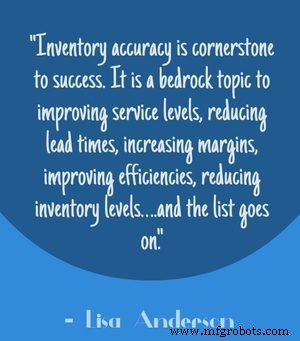
50. Follow best practices for conducting physical inventory counts. “Inventory accuracy is cornerstone to success. It is a bedrock topic to improving service levels, reducing lead times, increasing margins, improving efficiencies, reducing inventory levels….and the list goes on. Although I recommend implementing cycle counting programs as a way to replace physical inventories, there are times when a physical inventory is a must. Thus, it is worth thinking about a few tips to successfully complete a physical inventory.
- Prepare, prepare, and prepare: 80% of your success is in preparation. Organize the warehouse, clearly mark areas, label exceptions, complete and review system transactions, etc.
- Stop/isolate movement: When you begin your physical count, stop all physical and system movements and transactions. This is a critical foundation – similar to building a house, if you start adding windows prior to finishing the walls, the house might begin to fall apart.
- People and communication: Make sure the right people are in the right jobs for their skill sets. And, communicate, communicate, communicate. Make sure everyone has clear instructions, understands how to get questions answered, etc.
- Manage the control desk: This is the term I’ll use for the team organizing and controlling the process – the Grand Central Station hub. Typically, this person/team keeps track of count sheets, makes sure everything “adds up”, answers questions and keeps the process moving.
- Metrics/tracking progress: Putting the key metrics and vehicles in place to track progress is cornerstone to success. By reviewing these metrics, the leader can review progress, make adjustments as required and keep the process on track. Metrics also provide for a way to measure success.” – Lisa Anderson, Tips for Physical Inventory Success , LMA Consulting Group; Twitter:@LisaAndersonLMA
51. Give your employees tools that make them more efficient, which leads to more accurate inventory control. “Other than employees, inventory is a company’s largest asset. Reducing inventory levels and increasing inventory turns can lead to immediate savings on a company’s bottom line. Also, it’s important to consider the “landed cost” of your products. While your supplier may have a book price with bulk discounts, consider how much the product actually will cost you from the time you purchase it to the time it lands at your warehouse dock. Cargo fees, customs, and transportation add up quickly and can shrink profit margins. To navigate these challenges, consider these five tips:
- Reduce compounded safety stock: Most companies keep an extra cushion of inventory to account for unexpected demand. The problem is that when every vendor in a supply chain (raw material supplier, manufacturer, retailer) maintains that extra 5 percent to 10 percent of cushion, it adds up to unnecessary costs for each organization. The key is to communicate closely and often with your suppliers and trading partners to prevent overproduction and increased carrying cost for them. Find ways to collaborate and eliminate excess safety stock.
- Give employees tools to make them more efficient: In tough times, high-quality employees that you strive to retain can get burned out. They likely will absorb the duties of their more expendable colleagues. One way to keep them happier and more productive is to give them the technology tools that will make their jobs easier. Technology that automates tasks or offers predictive models about supply and demand will help reduce the manual aspects of their jobs, so they can focus on driving sales or broader strategies to help grow your business.
- Optimize your inventory: Simply said, you need to get rid of the inventory you don’t sell and get more of the inventory you do. The concept sounds straightforward but many small and midsize businesses have the wrong mix of inventory. While it may be painful to liquidate the inventory you spent precious resources to secure, having it take up warehouse space and require your team to manage it will cost you more in the long run. That space and mindshare could be spent on inventory that is hot and will turn over quicker, and that means more profit in your pocket. Take the short-term hit and implement a system that sheds products that don’t sell and invest in those that do.
- Focus on banner products: Growing up, there were just three kinds of soap at the grocery store:Dove, Dial, and Lava. Now a visit to the soap aisle could add another 15 minutes to a shopping trip because there are just too many choices. By adding variations to your product line versus introducing completely new and different products, you actually cannibalize your own sales and risk confusing customers to the point of apathy. Concentrate on your best products and create customer brand loyalty, which will create “customers for life” versus fickle ones.
- Manage to the future: Understand that in today’s economic climate, cash is king. If you are sitting in a good position, make cutbacks to your spending but invest in tools and people that will help you in the long run to grow your business and drive greater efficiency. With layoffs and companies eager to keep sales high, you can secure some top quality talent and excellent deals on the technology tools you need.
“In times like these, it is key to stay positive but manage realistically, cutting short-term costs that you can afford to cut. The important thing is to understand which assets are mission-critical and which ones need to be shed. Properly managing the No. 1 or No. 2 asset of your company will allow you to cut expenses and increase sales.” – Bill Harrison, Top Five Tips to Rescue Your Business with Inventory Management , AllBusiness; Twitter:@AllBusiness_com
Asset Tracking Solutions from Camcode:
- Inventory Control
- Inventory Management
- Custom Foil Labels
- Warehouse Signs
- Aisle Signs
- Stainless Steel Tags
- Floor Labels
- Security Labels
- Magnetic Labels
Tecnología Industrial
- Método y análisis de la corriente de malla
- Cómo las empresas pueden aprovechar IoT para la recopilación y el análisis de datos a gran escala
- Transformación digital 101 para OEM de petróleo y gas:4 consejos vitales para el éxito
- Perspectiva futura:IA y análisis de datos en el control de grúas
- 4 tipos de sistemas de control de inventario:control de inventario perpetuo frente a control periódico y los sistemas de administración de inventario que los respaldan
- 3 consejos para la gestión de inventario hospitalario:implementación de procesos de seguimiento de activos para agilizar la gestión de inventario
- ¿Qué es la contabilidad de inventario? Cómo funciona, tipos de contabilidad de inventario y más
- Códigos de barras frente a RFID:¿Cuál es la mejor tecnología de recopilación de datos y seguimiento de inventario?
- 27 expertos en gestión de inventario revelan el método de control de inventario número 1 para ahorrar dinero en los almacenes
- ¿Por qué digitalizar formularios de recopilación de datos y listas de verificación?
- Parámetros clave para elegir un método de corte de precisión de 2 ejes



